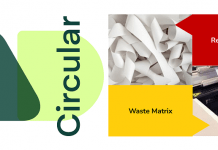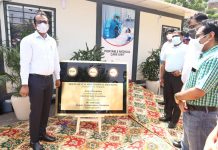Just before Christmas 2020, we had an opportunity to do an online interview with Mahesh Pathak, Avery Dennison’s senior director of operations for South Asia and Sub Saharan Africa, and Pankaj Bhardwaj, vice president and general manager, Avery Dennison India. The discussion centered on Avery Dennison’s new project in Greater Noida in the Delhi NCR, the pandemic’s impact on the Indian label industry, and, quite notably, sustainability.
Mahesh Pathak began by telling us about the Avery Dennison project in Greater Noida. “We have acquired a 12-acre plot of land, and the plan is to invest about Rs. 250 crore in Greater Noida near Delhi, in a state of the art manufacturing facility. This investment is part of our long-term strategy, and construction will begin shortly.
The new plant will use the latest technology – both for running the plant and for producing label stock. Pathak went on to say that the new plant will have next-generation technology in line with Industry 4.0. “It will be equipped with the technology to take us to something like a smart factory – state of the art in terms of equipment, speed, and technology. The plant will have one of the latest and fastest coating and lamination machines in this space globally.
“We will have an energy management system using IoT and a warehouse inventory management system based on RFID. We will have automation and probably use robots wherever possible and manufacturing execution systems (MES) – more digitization and automatic reporting systems.
“It will be a greener building – with a more energy-efficient machine, faster and more flexible. The product will be more sustainable, made with recycled materials as a part of the raw material inputs to manufacture label stocks. There are plans to add more functionality to the label stocks, although these plans are in a nascent stage. Since we already have plants in Pune, Bengaluru, and Kolkata, when the new Greater Noida plant is up and running, we will be covering all the four regions in the country – South, West, East, and now the North.”
Mahesh Bhardwaj added, “Yes the new plant is going to be more efficient in terms of speed, and it is going to be far more automated. In answer to your question about the pandemic and its effect on the new plant, it has not really impacted the Greater Noida project’s timeline. Of course, we had to think twice in Q2 because of the pandemic situation, but the packaging space’s recovery made us quite confident. The project is part of our long-term commitment to this market and our deep belief that this market offers enormous opportunities for growth and our ecosystem partners.
“There is a resilience of the packaging industry, and you are right in saying that the packaging industry has done relatively better in the pandemic. One can attribute it clearly to the resilience of the consumer in India. A lot of it has to do with product categories we participate in: in-home consumption, essential goods are two-thirds if not more, and some have done as well or better than in pre-pandemic times.
On the pandemic and its effect on packaging and labels
“Overall the recovery has been quite good. A few segments were impacted, but there has been a recovery in most segments. Apart from one or two, from the demand side, most of the segments we participate in have done well – home care, personal care, and even appliances. What is not doing well is alcoholic beverages.”
“From the supply side, we have had some hiccups like the rest of the industry, but we have been able to supply our customers, on the whole, quite well. We were lucky to start up within 48 hours of the lockdown in most of our locations, and we were able to service our customers reasonably well. Being a multinational with a large establishment in China, we had the advantage of some early learning of processes and protocols, one could say. These learnings had a benefit for our business continuity planning, and reflecting on this, we can say we are happy the way our team has shown resilience, and a retain its focus on serving the customers.”

How much of your raw materials can be sourced from within the country?
The two senior Avery Dennison executives explain that film face stocks can be sourced from within the country. “The majority of our film stocks are locally sourced because there are good manufacturers. The paper and liners are extremely import-dependent,” they say. “The pandemic has not changed much in this respect since these capabilities take time to build. Chemical components, including silicone, can be sourced locally, with some of the raw materials coming from outside and being mixed locally. We are still, however, at a ratio of 70/30 with 70% of the ingredients imported.”
Our anecdotal reports from the packaging and label market say that business has recovered or settled down to 80% of the pre-Covid days. Does this correlate with your business?
Pankaj Bhardwaj replies, “There is a segment-specific phenomenon. Alcobev may be back to about 80%, but I am a bit more optimistic than your figure overall and say that the other segments are now even better and could be near 90%.
“If you look at the macroeconomic environment – rural is almost 40% of Indian consumption which is holding its own and even marginally growing. It’s primarily the urban segments that have taken a turn or a dip. Some segments are in for a longer challenge, but others are doing well. For instance, I would have lost my bet on consumers buying large ticket items, and if you look at the large appliance companies, they have more supply-related challenges than demand related in the last couple of months.”
The pandemic has brought a change in the channel mix
“We had expected that modern retail would have done even better and that the kirana shops would be under pressure. But the pandemic has shown the opposite. Of course, we expected eCommerce to continue growing at 40%, but surprisingly the kirana stores are holding their own and not going anywhere. While modern retail was under tremendous pressure kirana’s are automating, which is great news for us. Let us remain cautiously optimistic.”
“eCommerce is an essential and integral part of our go-to-market strategy globally as well as in India. It is not just for labels but also for our other logistics solutions like RFID that are a part of inventory control and important. At the same time, we are continuously developing and providing various label stocks that can be applied to all types of surfaces, especially in the eCommerce segment. All of these players, who are automating their warehouses use WIP labels. They need to use some of our solutions, and we are in touch with them.
On exports from India in the pandemic
“As far as your question on exports, of whatever we produce in India, 20% is exported. And that has not changed during the pandemic. April and May of 2020 were tough times for exports as far as logistics being a challenge, but these came back. Nevertheless, we continue to remain bullish on using India as an export hub in the future, and the new plant will help make us more competitive in exports. We already do export to the Middle East and Africa.”
On anti-counterfeiting and anti-microbial solutions
“Apart from being difficult to copy, for anti-counterfeiting, the solution has to be far more complex, and there are multiple solutions – and there are no clear winners. It’s a challenge, and we have more to come. We have some answers, but these cannot be stand-alone solutions – they require partners in the ecosystem such as printers and digital solution providers. Anti-counterfeiting is something that has multiple solutions, and there is no clear winner. There are multiple solutions.
“For anti-microbial, we already have an offering in a part of our graphics solutions. These are films, and so far, the takers have not been labels but more in the area of wall graphics and vehicle graphics and others.”
We ask about the state of the recycling of liner and matrix in India.
Pathak fills us in by saying, “Liner and matrix both for recycling have been somewhat of a challenge globally as well in India. In early 2019 we rolled out a program that customers can submit both liner and matrix which we can down-cycle these into products and dispose of some parts in a non-hazardous way. We saw traction in 2019, but the project got a bit sidetracked in 2020 during the pandemic. We are giving a kind of refresher to this program. We are making it far more compelling to both the brand owners and the converters to give their waste for disposal.”
What about the increasing use of directly printed tubes instead of generic tubes with labels? Or in-mold labels. Will these impact the label converters?
Bhardwaj says, “It’s a challenge from one technology to another. PS has been gaining from wet glue, and IML has been gaining from PS to some extent. It is a challenge for us of how to make our technology more compelling. Both technologies are likely to grow, although PS labels would have an edge with not so large volumes and when there is a need for late-stage differentiation. You are right that a big change is happening as far as direct printing on tubes. As far as the direct printing on tubes and containers or in-mold labels, these are challenges that we have been facing from one technology or another. Both technologies should find their ground in time.”
On the headroom for label industry growth
Again Bhardwaj is optimistic, “We have a belief in consumer India where our consumption is less than one square meter per capita. There is a lot of headroom to grow, but this will not happen automatically. It requires a concerted effort by the industry to make brand owners aware. We have put several centers in the county. We have an R&D center, a knowledge center for the industry’s education and use, and these capabilities need to be utilized better. We need to be challenged more by our customers. I would say to our customers and the brand owners also – challenge us more! Collaborate with us!
If you compare the macroeconomics, countries such as Indonesia, Malaysia and Vietnam are very similar in trajectory and several economic parameters to our country. All of these countries are at similar demographics, similar per capita income, and their consumption levels of labels should be our true North for our benchmarking.
Label penetration is still one square meter per capita, and this can keep increasing for a long time, but it cannot happen by itself. It requires a concerted effort by showcasing our commitment and confidence in the market. While we are at 1 or 1.5 square meters per capita label consumption, all of these countries are at 1.5 to 2.5. Those countries should be our benchmark.
On sustainability
In ending, Bharadwaj says, “I want to touch on the subject of sustainability which is perhaps getting less attention than it deserves. We have come to a time when the drive for sustainability is no longer coming from the big brands – it is coming from every person and consumer. It is the gen Y who are increasingly conscious. It is the ask of every citizen, and our industry needs to do a big catch-up. We need to do more for sustainability. The industry is far behind the consumers in this respect.
“Residents of housing societies are now actually trying to sort waste at source. Our industry needs to do more on the sustainability front. The AD liner and matrix program is available to both brand owners and converters, and they need to take advantage of these. Far more needs to be done by the label industry by people coming together and discussing how we make our industry far more responsible than it is today. It’s not about having a discussion but having a bias for action. Let’s make the needle move!”








